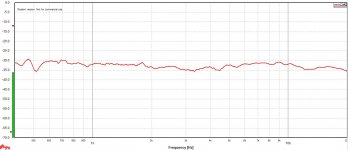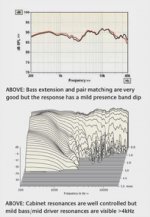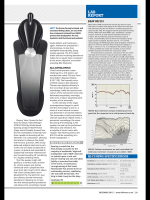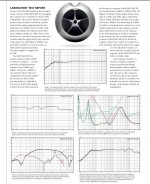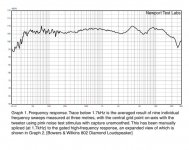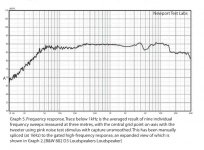Very interesting! The new D3 has basically everything changed, I would find hard to believe they sound still alike. I am looking forward to listening to those in April here at Chicago show.
Just one observation: isn't your frequency response correlated to the frequency response of your room? Or have you conducted your measurements in an anecoic chamber?
I am not an expert at all when it comes to acoustic measurements..so it might as well be that your measurements are not room dependent..I don't know...just thought of raising the point!!
Just one observation: isn't your frequency response correlated to the frequency response of your room? Or have you conducted your measurements in an anecoic chamber?
I am not an expert at all when it comes to acoustic measurements..so it might as well be that your measurements are not room dependent..I don't know...just thought of raising the point!!
Very interesting! The new D3 has basically everything changed, I would find hard to believe they sound still alike. I am looking forward to listening to those in April here at Chicago show.
Just one observation: isn't your frequency response correlated to the frequency response of your room? Or have you conducted your measurements in an anecoic chamber?
I am not an expert at all when it comes to acoustic measurements..so it might as well be that your measurements are not room dependent..I don't know...just thought of raising the point!!
The MLS measurement was taken in the near field - at a distance of about 0.6m , although I did take measurements at various distances, but in the near field the room effects are only obvious below 400Hz, which is where I set the low frequency limit of the analyser display.
Re the D3, there are some things that haven't changed. Firstly the new woofers are more or less the same composition, but the cone thickness is non uniform to reduce mass while retaining stiffness. The tweeter is also the same basic dome, and ditto the crossover design and crossover frequencies.
The new FST is also a woven fibre, like kevlar, but is designed to structurally distort itself at the top of its pistonic passband, which reduces the resonance issues. It's possible that the kevlar cone produces less distortion at 2kHz and below.
Actually, most of the changes to the enclosure and head appear to be borne out of the need to increase the level of automation in the manufacturing process. The new head is cast aluminium and the new plywood shell is also machine formed, which eliminates a huge labour cost and no doubt reduces the production time.
Of course, I'm sure that the performance is also better, but it's clearly not the only driver for the very substantial factory retooling.
Latest on axis measurement
And, also 45 degrees off axis
Interesting pair of measurements. Allows for easy adjustment to personal taste by adjusting the toe-in. I'd take the 30 degrees please. 🙂
Best,
Erik
Interesting pair of measurements. Allows for easy adjustment to personal taste by adjusting the toe-in. I'd take the 30 degrees please. 🙂
Best,
Erik
It's a nice choice.
Attachments
Axpona is coming up soon so I will be finally listening for my own at the D3 series!
Nevertheless, in the meantime, a very skilled person (from my viewpoint) whose judge I consider very valid, which was also a "fan" of B&W (this to say that he wasn't already prepared for the failure), had a chance to extensively listen to the new 802D3.
The guy owns a store in Italy and had gotten the speakers for a customer who wanted to buy 802D2 7-8 months ago and the owner of the store suggested the customer to just wait for the new series.
To make a long story short, unfortunately, he told me that new D3 is nothing to be excited about! It has the same problem with the upper register that affected the previous D2. Very hard to drive and definitely not a cohesive sound.
He was very disappointed, in fact, he was raving about this speaker long before it was available to the market saying that this speakers has the most number of patents of any other speaker in the market and that he was sure it was going to be a great deal.
Unfortunately, after he listened to it, his mindset changed. Customer wasn't happy either about his purchase either.
This is his the customer's second "less expensive" sound system anyway, and if you guys are wondering what he was using to drive the speakers, he uses Jeff Rowland 725 Monoblocks and Corus preamplifier, so something definitely up to the task.
At this point I am really looking forward to get my own direct experience with this speakers.
Nevertheless, in the meantime, a very skilled person (from my viewpoint) whose judge I consider very valid, which was also a "fan" of B&W (this to say that he wasn't already prepared for the failure), had a chance to extensively listen to the new 802D3.
The guy owns a store in Italy and had gotten the speakers for a customer who wanted to buy 802D2 7-8 months ago and the owner of the store suggested the customer to just wait for the new series.
To make a long story short, unfortunately, he told me that new D3 is nothing to be excited about! It has the same problem with the upper register that affected the previous D2. Very hard to drive and definitely not a cohesive sound.
He was very disappointed, in fact, he was raving about this speaker long before it was available to the market saying that this speakers has the most number of patents of any other speaker in the market and that he was sure it was going to be a great deal.
Unfortunately, after he listened to it, his mindset changed. Customer wasn't happy either about his purchase either.
This is his the customer's second "less expensive" sound system anyway, and if you guys are wondering what he was using to drive the speakers, he uses Jeff Rowland 725 Monoblocks and Corus preamplifier, so something definitely up to the task.
At this point I am really looking forward to get my own direct experience with this speakers.
That's very interesting.
There are plenty of rave reviews from customers - as well as the magazine reviews so far, but then again there was for the last model too after it was released.
I wonder if the listening height was too low? As per the D2 range, a suck-out at 2-3kHz develops at the height of the FST midpoint - because the driver's phase difference exceeds 90 degrees.
If I have time, I'll attempt another audition tomorrow.
There are plenty of rave reviews from customers - as well as the magazine reviews so far, but then again there was for the last model too after it was released.
I wonder if the listening height was too low? As per the D2 range, a suck-out at 2-3kHz develops at the height of the FST midpoint - because the driver's phase difference exceeds 90 degrees.
If I have time, I'll attempt another audition tomorrow.
Attachments
Last edited:
yes, please take another listening, I am curious to know more your listening impression.
Regarding the height I don't feel as concerned as you, obviously unless you are listening at the woofer's height or standing up, at that point I would suggest the guest to sit down in the listening position, but I don't believe there is this huge difference that makes me like or dislike the speaker if I am 3-4cm higher or lower than the tweeter.
I believe the tweeter should be pretty much at the level of your ears, is that correct?
Regarding the height I don't feel as concerned as you, obviously unless you are listening at the woofer's height or standing up, at that point I would suggest the guest to sit down in the listening position, but I don't believe there is this huge difference that makes me like or dislike the speaker if I am 3-4cm higher or lower than the tweeter.
I believe the tweeter should be pretty much at the level of your ears, is that correct?
For distances greater than 3m, there's less sensitivity to height, but about 1cm below the tweeter is optimum. You can also use the adjustable spikes to tilt them forward slightly.
The other thing to consider is toe-in. Because they're a bit directional in the 1-3kHz region it's best to toe-in either fully, or at least to within 30 degrees of the listening position.
The other thing to consider is toe-in. Because they're a bit directional in the 1-3kHz region it's best to toe-in either fully, or at least to within 30 degrees of the listening position.
Wow that's an interesting review!!!it really leaves me speechless and confused because of reports I got in this subject from that person I have quoted already.
I have checked exhibitors at axpona and b&w is not there...
Regarding the toeing doesn't the tweeter need to point at your ears or form the corner right behind your head?
I hope that who wants to listen to an 800 has at least 3 meters between them and speakers..
I have checked exhibitors at axpona and b&w is not there...
Regarding the toeing doesn't the tweeter need to point at your ears or form the corner right behind your head?
I hope that who wants to listen to an 800 has at least 3 meters between them and speakers..
The latest Australian HiFi has now included a tech review of the 802D3.
See attached, including the unsmoothed response measured at 3m (tweeter height) of the previous D2 version Vs the latest D3.
See attached, including the unsmoothed response measured at 3m (tweeter height) of the previous D2 version Vs the latest D3.
Attachments
I know B&W like their high crossover point for the 800 series but it's the designs biggest flaw. It creates such a huge sensitivity to listening height and distance that it's no surprise that opinions are divided. They should simply adopt a different strategy (lower the xover point) and give the speakers are wider and smoother, vertical, listening window.
I don't like to criticise in a design that has had so much thought, R&D and engineering expertise put into it. But simplistic xovers and crossovers so high, with such a large diameter midrange driver, are simply plagued by the laws of physics. A loudspeaker of this cost and pedegree should be listenable over a wide degree of sitting heights.
Edit - I am almost tempted to say that B&W should shrink the FST down to a 4" unit and make a 4 or 3.5 way design. As an example keep the 1" diamond, cross it in a 4kHz to the 4" FST. Have a 6" mid/bass below the FST and cross it over at ~700Hz. Then either cross in the 4th driver, say an 8" bass unit, as an entirely 4 way design, or have it act as a .5 way to the 6" mid/bass above it.
Alternatively B&W could do the 4 way in a different way entirely.
Use a 4" FST midrange and 1" Diamond tweeter, have these crossed over at 4kHz. Then have an 8" FST driver below it. Have these crossed over at ~700Hz, with the 8" FST covering down to around 200Hz. Then have some 8" bass drivers below this.
Both ways are more complex than what B&W have at the moment, but this would solve the 4kHz issue that plagues the current design ethos.
The easy way to solve this problem is to lower the xover frequency. This is simple and effective.
I don't like to criticise in a design that has had so much thought, R&D and engineering expertise put into it. But simplistic xovers and crossovers so high, with such a large diameter midrange driver, are simply plagued by the laws of physics. A loudspeaker of this cost and pedegree should be listenable over a wide degree of sitting heights.
Edit - I am almost tempted to say that B&W should shrink the FST down to a 4" unit and make a 4 or 3.5 way design. As an example keep the 1" diamond, cross it in a 4kHz to the 4" FST. Have a 6" mid/bass below the FST and cross it over at ~700Hz. Then either cross in the 4th driver, say an 8" bass unit, as an entirely 4 way design, or have it act as a .5 way to the 6" mid/bass above it.
Alternatively B&W could do the 4 way in a different way entirely.
Use a 4" FST midrange and 1" Diamond tweeter, have these crossed over at 4kHz. Then have an 8" FST driver below it. Have these crossed over at ~700Hz, with the 8" FST covering down to around 200Hz. Then have some 8" bass drivers below this.
Both ways are more complex than what B&W have at the moment, but this would solve the 4kHz issue that plagues the current design ethos.
The easy way to solve this problem is to lower the xover frequency. This is simple and effective.
Last edited:
To lower the crossover frequency, B&W would need to use a higher order filter and move away from their current approach of moving the tweeter forward by 1.7 inches.
Perhaps an easier solution would be to cross over at 2-3kHz and revert to a third order electrical network on the tweeter, and also make the head tilt-able, as per Wilson Alexia's, which would allow the end user to fine tune the lobe.
Perhaps an easier solution would be to cross over at 2-3kHz and revert to a third order electrical network on the tweeter, and also make the head tilt-able, as per Wilson Alexia's, which would allow the end user to fine tune the lobe.
An easier solution sounds like going all active and doing it all digitally. 🙂
Erik
The only thing easy about this approach is the tweakability (easy to modify, save & recall configurations). However, it is every bit as difficult to get right, especially if you're striking out in your own new direction.
If going this route, an approach I would take would be to first emulate the passive design in order to establish a benchmark. Then one can introduce various alternative ideas. The best thing about it is that you can produce a crossover design optimised for your own listening setup. Note of caution though: highly optimised/customised designs have the potential (high probability) of being less compatible with other listening environments. But, again, with a digital-based system you can always revert to the original version (or other) if needs be.
[It feels like I've written all this before. Sorry if that's the case.]
I agree that getting the electroacoustics is not trivial, but I mentioned this for one important reason: Time alignment!
Much easier in the digital domain.
Best,
Erik
Much easier in the digital domain.
Best,
Erik
The only thing easy about this approach is the tweakability (easy to modify, save & recall configurations). However, it is every bit as difficult to get right, especially if you're striking out in your own new direction.
If going this route, an approach I would take would be to first emulate the passive design in order to establish a benchmark. Then one can introduce various alternative ideas. The best thing about it is that you can produce a crossover design optimised for your own listening setup. Note of caution though: highly optimised/customised designs have the potential (high probability) of being less compatible with other listening environments. But, again, with a digital-based system you can always revert to the original version (or other) if needs be.
[It feels like I've written all this before. Sorry if that's the case.]
Did anybody go to the Axpona this year?
I did go and I can comment that most of the very expensive audio rooms sounded very disappointing!
B&W wasn't there except for a bad sounding room with older Nautilus 802.
I did go and I can comment that most of the very expensive audio rooms sounded very disappointing!
B&W wasn't there except for a bad sounding room with older Nautilus 802.
Located here in EU think will get a opportunity to hear new B&W in some months, about a month ago had a listen in a shop on new Beolab 90 flagship, that was good sound quality experience but also expected with such a price tag.
Located here in EU think will get a opportunity to hear new B&W in some months, about a month ago had a listen in a shop on new Beolab 90 flagship, that was good sound quality experience but also expected with such a price tag.
what electronics were connected to the system?
I never listened to these speakers, what kind of sound do they produce?
- Home
- Loudspeakers
- Multi-Way
- B&W Signature 800 upgrade diamond tweeter
